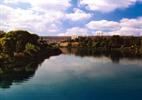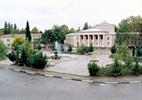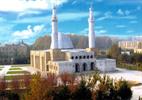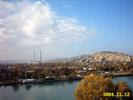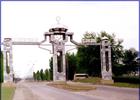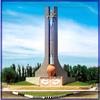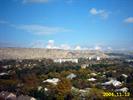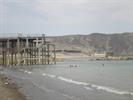Mingachevir (Mingachaur in Russian) is one of those towns that, with residual Soviet zeal, many locals describe as 'beautiful'. While there are some well-designed government buildings and plenty of parks to break up the regimented grid of concrete homes, 'liveable' would be a better description or 'relaxed'. Even Lenin (while his statue lasted) used to sit cross legged on a park bench rather than standing and pointing.
Today Lenin's gone to bed but some other fairly imaginative sculptures remain and there's a hypnotic charm to staring at the surreal opal-blue waters of the River Kura from one of the terrace restaurants and tea houses scattered along either bank. Mingachevir is known as city of lights because of its hydroelectric power station on the Kur River, which splits the city in half. The area has been settled for thousands of years, but the current city was founded in 1948, partly by German soldiers who were taken prisoner during World War II.
Smaller than it looks, the History Museum (Mon-Fri, 9-13, 14-18:00) shows some interesting cut-aways of prehistoric grave-sites, has decent models of ancient homesteads and recreates the interior of a Lahic style smithy. There's also a Martyrs' Museum (10-14, 15-19:00 daily) if you want yet another reminder of national sul-fering in the 20th century.
The Grand Mosque is a new, sandstone edifice in lovingly-tended grounds. Its grey marble interior has an impressive giant chandelier. The twin, silvered minarets look like intercontinental balistic milk-churns.
Mingachevir's raison d'etre is its large 1949 hydro-electric dam, 3km from the town centre. It provides citizens with a supply of water/electricity which is unusually reliable for provincial Azerbaijan. The population is vocally happy about this. Killjoy experts have been warning for years that the dam faces a catastrophic collapse if not strengthened, but fortunately this was not borne out in the heavy rains of 2003.
The reservoir that the dam created is Azerbaijan's biggest lake and has submerged many rich archaeological sites, the best finds from which are displayed in Baku's Historical Museum. During the ultra-dry summer of 2000 the water retreated exposing many new finds - one group of expats stumbled upon a fossilized mammoth. With a 4WD it was possible to drive for miles along the shore. In contrastingly wet 2003 the water was so high that even the beaches disappeared.
The most accessible such 'beach' is just beyond the dam. On the gentle rise above the rotting jetty nearby is the summer-only Ateshgah Cafe. It's a pleasant place for tea with lake views but its real attraction is the easy to miss subterranean cavern beneath. Here a surreal acid-trip bar is guarded by a giant spider. An attached nightclub decked with glass-fibre sta-lagtites has a stream cascading through the middle. It's worth a look even when the bar is not officially operating.
History of Mingechevir
Despite the fact that Mingecevir is a young town, the territory where the town is located is known as an ancient abode. The history of this abode covers a period from the eneolith era (3000 BC) to the AD 17th century.
It was the chairman of the Caucasus archeological committee, A. I. Berje, who first gave information about the archeological monuments of Mingecevir at the second congress of archeologists in St Petersburg in 1871. Although this information was not precise, Berje presented Mingecevir as an ancient settlement.
After this, Mingecevir remained out of archeologists’ attention for many years. Archeological researches resumed in Mingecevir only in mid-1930s as part of the construction of the hydroelectric power station. The researches started under the leadership of Prof. Pakhomov in 1935. These researches revealed two ancient settlements and cemeteries, which were composed of various types of graves. Unfortunately, World War II prevented the research being completed.
The construction of the hydroelectric power station started immediately after the war. This marked a start of systematic and planned research of Mingecevir as an ancient abode. Archeological excavations were carried out from April 1946 to August 1953 by a group of archeologists headed by S. M. Qaziyev in connection with the construction of the Mingecevir hydroelectric power station under a decision by the Supreme Board of the Azerbaijani Academy of Sciences. Over 20,000 historical monuments – graves and tumuli, means of production, things related to daily life, jewelry etc., which reflected historical periods in chronological sequence, were found during the excavations.
Most ancient written monuments in Caucasian Albanian alphabet and other archeological finds proved that Mingecevir was a 5,000-year-old abode. The majority of these finds are currently exhibited in the Azerbaijani Historical Museum, while part of them is held at the Mingecevir Historical Museum.
History knows a great deal of facts about ancient Mingecevir. Historical sources indicate that a fierce battle took place between the powerful army of Roman commander Pompey and the army of Albanian governor Oris just on the territory of the current dam on the bank of the River Kur in the 1st century BC. Historical facts also prove that the ancient Silk Road laid via Mingecevir.
Renowned Turkish traveler Ovliya Calabi, who lived in the AD 17th century, wrote about Mingecevir and described it as a large settlement on the right bank of the River Kur near the Bozdag Mountain. According to him, several mosques, workshops manufacturing fiber silk and silk cloth, bathhouses etc. were operating in this settlement. Interestingly, the road passing from here used to be called the "road of messenger". The "road of messenger" was connecting lots of camelcade and trade roads to Middle East countries and Azerbaijani towns like Saki, Qabala, Samaxi, Barda, Beylaqan and others.
A great number of people came to Mingechevir from all districts in Azerbaijan in connection with the construction of the Mingechevir hydroelectric power station, and a total of 20,000 people took part in the construction of this power station. About 10,000 German POWs were among those who contributed to the construction of this power station by the end of the 1940s. The most experienced specialists of the country were involved in the construction of this building site as the biggest hydroelectric power station of the then Soviet Union.
Today's Mingechevir, which was built in connection with the hydroelectric power station, was granted a status of town in 1948. The population of the town currently stands at 120,000 people, including 20,000 internally displaced people from Karabakh and the occupied adjacent districts. The area of the town is 139.53 km2. Mingechevir is situated 55 meter above sea level on the foothill of the southeast of the Bozdag Mountain chain and on the edge of the Mingechevir reservoir in the Kur-Araz lowland in central Azerbaijan. The town was built in a mild and warm zone and has warm and dry summer, while mild winter. The average annual temperature is 14 - 15 °C, highest temperature 42 °C (July-August) and the lowest temperature (January-February) -10 °C. The average annual rain constitutes 250–300 mm.
The town lies on both banks of the River Kur - a 1515 km-long river, which is the biggest and longest one in the South Caucasus. (The river originates from Turkey, runs down Georgia and Azerbaijan and flows to the Caspian Sea.) Mingechevir is situated in 280–300 km west of the capital of the republic, Baku.
Mingechevir has been developing speedily over the last 54 years, since it has been established. Mingechevir, which is currently considered to be the fourth town of the country both for its economic potential and the number of population, is one of the central towns of the republic in terms of energy, industry, science, education and culture. The number of able-bodied people in Mingechevir is 53,000, while the number of people actually involved in labor is 16,000.
If you're planning a trip to Azerbaijan you may be interested ▶ Azerbaijan highlights - For those who prefer to go unbeaten path, to explore less visited places and check national charisma of this small country in Southern Caucasus on the edge of Europe.



